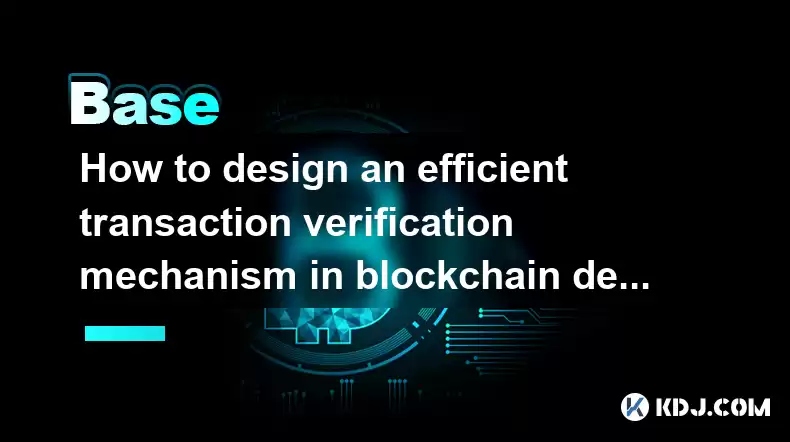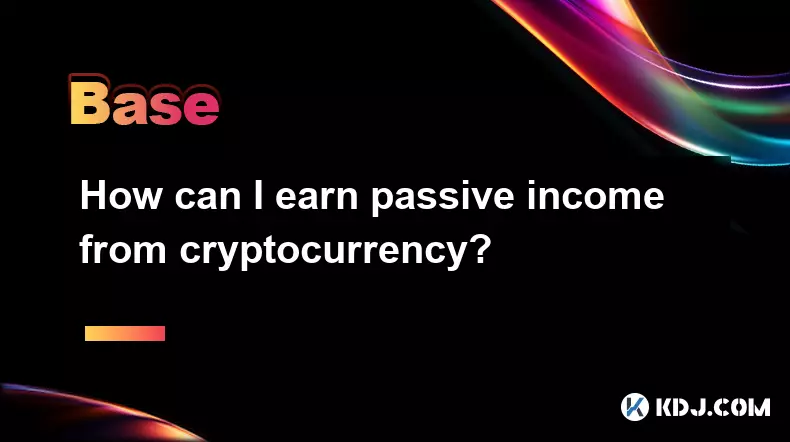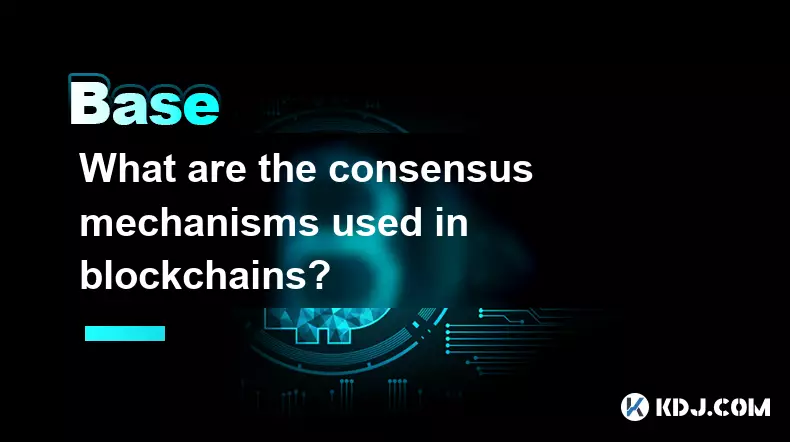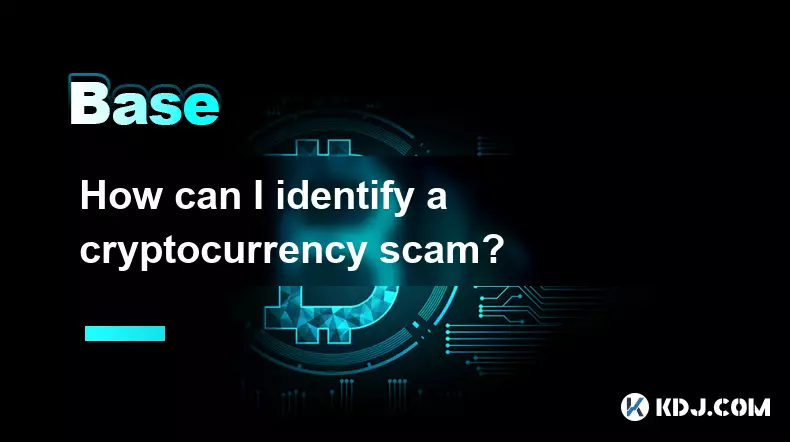-
 bitcoin
bitcoin $112371.712755 USD
-0.18% -
 ethereum
ethereum $4188.969598 USD
-0.18% -
 tether
tether $1.000202 USD
-0.05% -
 xrp
xrp $2.834903 USD
-0.51% -
 bnb
bnb $1021.658413 USD
3.04% -
 solana
solana $215.188750 USD
-1.77% -
 usd-coin
usd-coin $0.999803 USD
0.00% -
 dogecoin
dogecoin $0.239438 USD
-0.51% -
 tron
tron $0.336588 USD
-1.10% -
 cardano
cardano $0.812415 USD
-1.22% -
 hyperliquid
hyperliquid $45.019578 USD
-2.90% -
 chainlink
chainlink $21.594825 USD
-0.13% -
 avalanche
avalanche $34.271321 USD
2.56% -
 ethena-usde
ethena-usde $1.000931 USD
-0.07% -
 sui
sui $3.354033 USD
-0.29%
How to design an efficient transaction verification mechanism in blockchain development?
Efficient blockchain transaction verification prioritizes speed, cost, and security, leveraging techniques like PoS consensus, optimized Merkle trees, sharding, lightweight clients, and robust security protocols to balance performance with resilience against attacks.
Mar 07, 2025 at 02:24 am

- Defining Transaction Efficiency in Blockchain: Focuses on speed, cost, and security.
- Consensus Mechanisms and their impact on verification speed.
- Data Structures: Optimizing Merkle Trees and other data structures for faster verification.
- Sharding and Parallel Processing: Distributing the workload for faster transaction processing.
- Lightweight Clients and Proof of Verification: Reducing the computational burden on nodes.
- Security considerations: Balancing speed with robust security against double-spending and other attacks.
- Practical implementation challenges: Scalability, interoperability, and maintaining decentralization.
Designing an efficient transaction verification mechanism is crucial for the scalability and usability of any blockchain. Efficiency in this context encompasses speed, cost, and security. A slow or expensive verification process hinders adoption, while a vulnerable mechanism jeopardizes the entire system. This article explores key strategies for achieving efficiency.
First, we must define what constitutes an "efficient" transaction verification mechanism. It should process transactions quickly, minimizing latency between submission and confirmation. The cost, in terms of computational resources and energy consumption, should be low for both individual nodes and the network as a whole. Finally, and critically, the mechanism must be secure, resistant to attacks like double-spending and 51% attacks.
The choice of consensus mechanism significantly impacts verification efficiency. Proof-of-Work (PoW) systems, while secure, are notoriously slow due to the computational intensity of mining. Proof-of-Stake (PoS) mechanisms, on the other hand, generally offer faster transaction confirmation times due to their reduced energy consumption and reliance on validators rather than miners. Other consensus mechanisms like Delegated Proof-of-Stake (DPoS) and Practical Byzantine Fault Tolerance (PBFT) also provide varying degrees of speed and security trade-offs.
Efficient data structures are paramount. Blockchain relies heavily on Merkle trees to efficiently verify large sets of transactions. Optimizing Merkle tree construction and traversal algorithms can drastically improve verification speed. Furthermore, exploring alternative data structures tailored to specific blockchain needs can further enhance efficiency. Consider the use of Bloom filters for faster data lookups.
Sharding, a technique that partitions the blockchain into smaller, more manageable pieces, is a powerful tool for improving scalability and transaction verification speed. By distributing the workload across multiple shards, the network can process transactions in parallel, significantly reducing overall latency. However, careful design is needed to ensure data consistency and security across shards.
Lightweight clients are designed to verify transactions without downloading the entire blockchain. They rely on simplified verification methods, such as relying on trusted sources for block headers, significantly reducing computational overhead for individual users. This improves accessibility and efficiency for users with limited resources. Proofs of verification, cryptographic techniques that allow verification without full data access, are also relevant here.
Security remains paramount. While optimizing for speed, it's crucial to maintain robust security against various attacks. This includes measures to prevent double-spending, replay attacks, and Sybil attacks. The chosen consensus mechanism and cryptographic algorithms directly influence the system's security. A trade-off often exists between speed and security; careful design balances these competing needs.
Implementing these strategies presents practical challenges. Scalability remains a significant hurdle, as even with optimizations, transaction throughput can become a bottleneck with increasing network usage. Interoperability with other blockchains is another challenge, requiring standardized protocols and data formats. Finally, maintaining decentralization while improving efficiency is a delicate balancing act. Over-centralization can compromise the fundamental principles of blockchain technology.
Frequently Asked Questions:Q: What are the major bottlenecks in blockchain transaction verification?A: Major bottlenecks include the consensus mechanism's speed, the computational cost of verifying transactions (especially with large block sizes), network latency, and the need to maintain data consistency across the entire network.
Q: How does sharding improve transaction verification efficiency?A: Sharding divides the blockchain into smaller shards, allowing parallel processing of transactions. This drastically reduces the workload on individual nodes, leading to faster verification times and increased throughput.
Q: What are the security implications of using lightweight clients?A: Lightweight clients rely on trusted sources for information, introducing a degree of trust that compromises the fully decentralized nature of the system. Careful selection of trusted sources and mechanisms to detect malicious behavior are crucial.
Q: Can different consensus mechanisms be combined for improved efficiency?A: Yes, hybrid approaches combining the strengths of different consensus mechanisms are being explored. For example, a system might use a fast consensus mechanism for everyday transactions and a more secure, slower mechanism for high-value or critical transactions.
Q: How can we balance speed and security in transaction verification?A: This involves careful selection of algorithms, cryptographic primitives, and consensus mechanisms. It often involves a trade-off; faster mechanisms might sacrifice some security, while highly secure ones might be slower. Thorough security audits and rigorous testing are crucial.
Disclaimer:info@kdj.com
The information provided is not trading advice. kdj.com does not assume any responsibility for any investments made based on the information provided in this article. Cryptocurrencies are highly volatile and it is highly recommended that you invest with caution after thorough research!
If you believe that the content used on this website infringes your copyright, please contact us immediately (info@kdj.com) and we will delete it promptly.
- Lombard, Crypto Price, and South Korea: Decoding the Hype
- 2025-09-24 14:25:15
- Hemi, Binance, and Airdrops: What's the Buzz?
- 2025-09-24 12:25:12
- Cloud Mining, Bitcoin, and Litecoin: Navigating the Crypto Landscape in 2025
- 2025-09-24 10:45:12
- Bitcoin, California, and the Governor's Race: A New Era?
- 2025-09-24 10:45:12
- DEX Competition Heats Up: Hyperliquid's Incentives Under Pressure
- 2025-09-24 10:50:01
- MetaMask Token Airdrop: Opportunities, Concerns, and the Hype Train
- 2025-09-24 10:50:01
Related knowledge

How can I earn passive income from cryptocurrency?
Sep 23,2025 at 10:18am
Staking Cryptocurrencies for Regular Returns1. Many blockchain networks operate on a proof-of-stake (PoS) consensus mechanism, allowing users to earn ...

What are the consensus mechanisms used in blockchains?
Sep 24,2025 at 10:00am
Proof of Work and Its Role in Blockchain Security1. Proof of Work (PoW) is one of the earliest consensus mechanisms, first implemented by Bitcoin. Min...

Is there a finite supply of Bitcoin?
Sep 23,2025 at 06:00am
Bitcoin's Fixed Supply Mechanism1. Bitcoin was designed with a hard cap of 21 million coins, making its supply finite and predictable. This limit is h...

How do decentralized exchanges (DEXs) work?
Sep 23,2025 at 09:54pm
Understanding the Mechanics of Decentralized Exchanges1. Decentralized exchanges operate without a central authority, allowing users to trade cryptocu...

How are cryptocurrency transactions taxed?
Sep 23,2025 at 04:36am
Taxation of Cryptocurrency TransactionsCryptocurrency transactions are subject to various tax regulations depending on jurisdiction, usage, and freque...

How can I identify a cryptocurrency scam?
Sep 24,2025 at 04:36am
Red Flags in Project Documentation1. The whitepaper lacks technical depth and avoids explaining the underlying blockchain mechanics. It often uses buz...

How can I earn passive income from cryptocurrency?
Sep 23,2025 at 10:18am
Staking Cryptocurrencies for Regular Returns1. Many blockchain networks operate on a proof-of-stake (PoS) consensus mechanism, allowing users to earn ...

What are the consensus mechanisms used in blockchains?
Sep 24,2025 at 10:00am
Proof of Work and Its Role in Blockchain Security1. Proof of Work (PoW) is one of the earliest consensus mechanisms, first implemented by Bitcoin. Min...

Is there a finite supply of Bitcoin?
Sep 23,2025 at 06:00am
Bitcoin's Fixed Supply Mechanism1. Bitcoin was designed with a hard cap of 21 million coins, making its supply finite and predictable. This limit is h...

How do decentralized exchanges (DEXs) work?
Sep 23,2025 at 09:54pm
Understanding the Mechanics of Decentralized Exchanges1. Decentralized exchanges operate without a central authority, allowing users to trade cryptocu...

How are cryptocurrency transactions taxed?
Sep 23,2025 at 04:36am
Taxation of Cryptocurrency TransactionsCryptocurrency transactions are subject to various tax regulations depending on jurisdiction, usage, and freque...

How can I identify a cryptocurrency scam?
Sep 24,2025 at 04:36am
Red Flags in Project Documentation1. The whitepaper lacks technical depth and avoids explaining the underlying blockchain mechanics. It often uses buz...
See all articles










































































